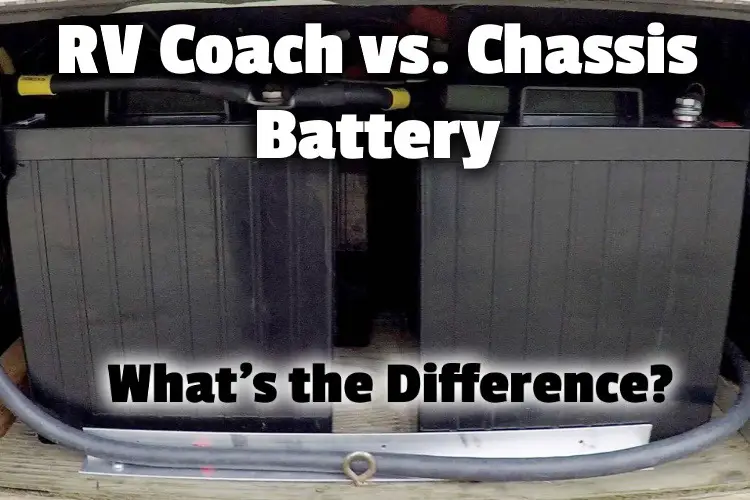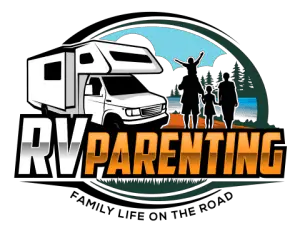As an RV owner, you know that most RVs have a battery for the motor, just like a car battery. But they also have a battery, or even multiple batteries, to power the inside of the RV, too. This has some people wondering: What’s the difference between the RV coach vs. chassis battery.
Motor homes have two different battery systems. The “house” or “coach” batteries provide 12-volt DC power to operate non-engine electrical accessories, such as interior lighting. The chassis battery(s) provides power to start the engine & run automotive items such as the windshield wipers and vehicle lighting.
But that’s not all there is to know about RV batteries.
So in this article, we’ll explore both types of batteries. Can one charge the other? If one dies, can you use the other? Is one as easy to replace as the other?
You’ve got questions. I’ve got answers. Just keep reading!

Does an RV generator charge the chassis battery?
For most RVs, the generator does not charge the chassis battery. It only charges the coach battery. However, some RVs do allow you to charge both off of the generator.
It sure seems like an RV generator should charge all of the batteries.
But generally speaking, this may not be true. Older motorhomes lack the electrical circuitry to charge both the RV coach and chassis batteries.
While it’s difficult to answer this question for every make and model of a motorhome, engine batteries are generally charged while driving.
That said, there are a couple of things you can do to charge your chassis battery. First, you can drive it pretty frequently. You should run your coach at least every two weeks for a 20-mile or so trip. This will get things moving, lubrication running, and bearings pumping.
It will also help charge your battery.
Second, you can add a “pig-tail” lead to your chassis battery so that you can quickly plug in an external battery charger. This can usually be plugged into an available 20 amp outlet.
Finally, you can install a Trik-L-Start, or some other system, to charge the chassis battery from coach batteries if on the generator.
These devices connect the house batteries to the chassis battery to provide a trickle charge to the chassis battery.
Changing out 6v coach batteries⚡️⚡️⚡️ Cleaning the terminals⚡️⚡️⚡️ #rvlife #goRVing #fulltimerv #camping #rv pic.twitter.com/jnksaJy53u
— Class A RV Service (@ClassRv) April 27, 2016
Does plugging in your RV charge the battery?
Yes, plugging-in your RV to a campground 50-amp connector will charge at least the house battery. As with using the generator, campground electricity does not typically charge the chassis battery.
You can charge your camper house battery by plugging it into a 30 or 50 amp outlet at a campground, national park, or state park.
You can also hook it up through a 15 or 20 amp power outlet at home; just don’t expect to run the AC when doing that.
When an RV is hooked up to the electrical grid, it’s known as “shore power.”
While the camper is hooked up to shore power, it will automatically begin to charge the house battery and run your electrical appliances simultaneously.
But you want to make sure your system doesn’t get overloaded from a power spike.
You can do this by plugging in a surge protector at the campsite and then plugging in your camper to that. This will protect your camper from power spikes and prevent any damage to your electrical outlets.
The surge protector I got for my RV was this one on Amazon.
It works great, and it’s easy to tell if everything is good just looking for the 3 green lights at the top to be lit up. Prime shipping and hundreds of great reviews make that even better.
You can also charge batteries at home the same way they are charged at a campsite. Just make sure you are using a heavy-duty outdoor extension cord.
Finally, if your camper is small enough, you can take the battery out and charge it with a 12-volt battery charger inside your home.
Someone gives you this solar powered RV that runs with no fuel and now need of charging stations.
How would it change your life?
What would it give you the freedom to do?
Where’s the first place you would go? pic.twitter.com/DBLU0LMI5D
— SueMe (@SiouxSkelding) August 8, 2020
Does driving an RV charge the house batteries?
No. Just starting the RV engine does not automatically charge the house battery as it does the chassis battery. While you can modify your RV to do this, the simplest way of charging the house battery is with the generator or being hooked up to electricity.
An RV battery is a 12-volt power unit capable of supplying all the energy your RV needs. It can store enough energy to keep all of your electrical appliances and the HVAC operational.
To charge this powerhouse while you are driving, you’ll need a few things. You’ll need a voltage controlled relay (VCR), Anderson plugs, and high amperage cables.
First, connect the VCR to the start and auxiliary batteries.
The relay will open when the RV’s engine kicks off—turning the engine off disconnects the batteries of the chassis and house, setting the voltage back to preset levels.
You’ll need high-quality cables and plugs to connect the RV battery to the chassis battery.
Using high-quality cables and plugs will create stable connections and lower the voltage drop. It will also ensure that the connection will not be lost over rough terrain. Attaching a 50 amp auto-reset circuit breaker to the battery’s positive side will also help prevent fire hazards.
Remember to monitor the battery while you’re driving. You don’t want to overcharge it.
This Solar-Powered RV Runs Without Fuel Or Charging Stations #Travel #Transport #Solar #ElectricVehicles #FutureOfWork https://t.co/vgHPanNWXS pic.twitter.com/06KKQHs3NY
— plus530 (@plus530) March 3, 2020
How do you charge RV house batteries?
The best way to charge your RV house battery is by either running your generator or being connected to an electrical connection at a campground.
You can charge your camper battery by plugging it into a 30 or 50 amp outlet at a campground, national park, or state park.
You can also hook it up through a 15 or 20 amp power outlet at home.
But you want to make sure your system doesn’t get overloaded from a power spike. You can do this by plugging in a surge protector at the campsite and then plugging in your camper to that.
This will protect your camper from power spikes and prevent any damage to your electrical outlets.
While the camper is hooked up to shore power, it will automatically begin to charge the battery and run your electrical appliances at the same time.
On the road, the house battery can be charged through a generator. The generator would run your AC appliances directly and charge your battery at the same time.
On extended road trips, using the alternator is an excellent option for charging your house batteries.
This is a great option if you are not planning on staying in one place for long. If you are going to stay somewhere for an extended period, you’d have to idle your vehicle to charge the battery. This is inefficient and can cause unnecessary wear and tear on your vehicle.
Solar power and wind power use either solar panels or wind turbines to an amp controller, which then goes to the battery.
Wind power is the least popular of these choices, as you have to live in a windy area and not move your camper very often.
While here I’m charging the Motorhome battery and taking it for a drive. We may even bring it home today #RVLife pic.twitter.com/bSTwLHuiHG
— Calvin Pearce (@pearceauto) June 14, 2020
Can my chassis battery charge the house battery?
Yes. A chassis battery will typically charge the house battery in most RVs while the RV is driving. A solenoid connects the 2 batteries and allows charging when there is a key in the ignition turned to on. Just make sure to start the engine to avoid draining the chassis battery.
Chassis batteries are kept separate from the house batteries. This is to ensure that once the house batteries run too low, the engine will still start with the chassis battery.
A charge solenoid is installed to connect the chassis and house batteries together. The solenoid is engaged whenever the ignition key is in the “on” position. The engine can then recharge the house batteries while driving down the road.
As soon as you are parked, the solenoid opens, and the batteries are disengaged.
If you are parked at a campsite, you can run the engine to charge the house batteries. But that is inefficient.
Instead, you would be better off using a battery charger and a converter. The converter will charge the battery and provide consistent voltage to power the 12-volt electrical components while you are parked.
With this method, you won’t need to use the batteries to power the electrical components.
Final Thoughts
Motor homes have two different battery systems.
The house batteries provide 12-volt DC power to operate non-engine electrical accessories, such as interior lighting. The chassis batteries provide power to start the engine and supply power to driving-related accessories, like the windshield wipers and vehicle lighting.
Typically, the chassis battery is charged while driving. Still, you can purchase devices to connect the two electrical systems to charge the chassis battery while charging the house battery.
House batteries can be charged by shore power, generator, solar power, or even wind power.
Photo which requires attribution:
Battery Bank Compartment by RVWithTito.com is licensed under CC2.0
Middle Class Dad is a participant in the Amazon Services LLC Associates Program, an affiliate advertising program designed to provide a means for sites to earn advertising fees by advertising and linking to Amazon.com. As an Amazon Associate, I may earn a small commission from qualifying purchases if you click to Amazon from my site and choose to make a purchase. This is no way increases the cost to you.
